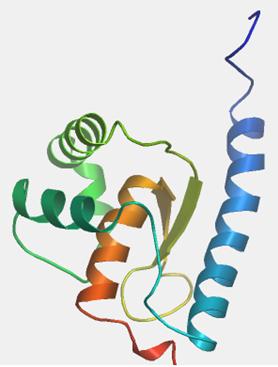
A leucine zipper is a common three-dimensional structural motif in proteins. They were first described by Landschulz and collaborators in 1988 when they found that an enhancer binding protein had a very characteristic 30-amino acid segment and the display of these amino acid sequences on an idealized alpha helix revealed a periodic repetition of leucine residues at every seventh position over a distance covering eight helical turns. The polypeptide segments containing these periodic arrays of leucine residues were proposed to exist in an alpha-helical conformation and the leucine side chains from one alpha helix interdigitate with those from the alpha helix of a second polypeptide, facilitating dimerization.

Transport and golgi organization 2 homolog (TANGO2) also known as chromosome 22 open reading frame 25 (C22orf25) is a protein that in humans is encoded by the TANGO2 gene.

CXorf26, also known as MGC874, is a well conserved human gene found on the plus strand of the short arm of the X chromosome. The exact function of the gene is poorly understood, but the polysaccharide biosynthesis domain that spans a major portion of the protein product, as well as the yeast homolog, YPL225, offer insights into its possible function.

DEPDC5 is a human protein of poorly understood function but has been associated with cancer in several studies. It is encoded by a gene of the same name, located on chromosome 22.
Coiled-Coil Domain Containing 11, also known as CCDC11 is a protein, that is encoded by CCDC11 gene located at chromosome 18 in humans.
Uncharacterized LOC644249 gene., also known as RP11-195B21.3, is about 1058 base pairs long and is found in Homo sapiens on chromosome 9q12. More specifically, the sequence is located on Chromosome: 9; NC_000009.11(67977457..67987991 bp). This gene’s protein product is the “coiled-coil domain-containing protein 29” which is 291 amino acids long and may contain a conserved domain in the superfamily, pfam 12001. In particular, this conserved domain contains the domain of unknown function DUF3496 which is about 110 amino acids long, functionally uncharacterized, and found in eukaryotes. Other possible motifs for the protein product exist but the DUF3496 remains the most likely. This protein may play a role as a transmembrane protein.

Glutamine Serine Rich Protein 1 or QSER1 is a protein encoded by the QSER1 gene.

Coiled coil domain containing protein 120 (CCDC120), also known as JM11 protein, is a protein that, in humans, is encoded by the CCDC120 gene. The function of CCDC120 has not been formally identified but structural components, conservation, and interactions can be identified computationally.
Transmembrane protein 33 is a protein that in humans, is encoded by the TMEM33 gene, also known as SHINC3. Another name for the TMEM33 protein is DB83.

WW and C2 domain containing 2 (WWC2) is a protein that in humans is encoded by the WWC2 gene (4q35.1). Though function of WWC2 remains unknown, it has been predicted that WWC2 may play a role in cancer.

Coiled Coil Domain Containing protein 42B, also known as CCDC42B, is a protein encoded by the protein-coding gene CCDC42B.

Coiled-coil domain 47 (CCDC47) is a gene located on human chromosome 17, specifically locus 17q23.3 which encodes for the protein CCDC47. The gene has several aliases including GK001 and MSTP041. The protein itself contains coiled-coil domains, the SEEEED superfamily, a domain of unknown function (DUF1682) and a transmembrane domain. The function of the protein is unknown, but it has been proposed that CCDC47 is involved in calcium ion homeostasis and the endoplasmic reticulum overload response.

PROSER2, also known as proline and serine rich 2, is a protein that in humans is encoded by the PROSER2 gene. PROSER2, or c10orf47(Chromosome 10 open reading frame 47), is found in band 14 of the short arm of chromosome 10 (10p14) and contains a highly conserved SARG domain. It is a fast evolving gene with two paralogs, c1orf116 and specifically androgen-regulated gene protein isoform 1. The PROSER2 protein has a currently uncharacterized function however, in humans, it may play a role in cell cycle regulation, reproductive functioning, and is a potential biomarker of cancer.
Chromosome 16 open reading frame 95 (C16orf95) is a gene which in humans encodes the protein C16orf95. It has orthologs in mammals, and is expressed at a low level in many tissues. C16orf95 evolves quickly compared to other proteins.

C14orf93 is a protein that is encoded in humans by the C14orf93 gene. It is a globular protein with a conserved C-terminus that is localized to the nucleus. While expressed relatively highly in all tissues except nervous tissue, it is expressed particularly highly in T cells and other immune tissues.

Uncharacterized protein C2orf73 is a protein that in humans is encoded by the C2orf73 gene. The protein is predicted to be localized to the nucleus.
Transmembrane Protein 217 is a protein encoded by the gene TMEM217. TMEM217 has been found to have expression correlated with the lymphatic system and endothelial tissues and has been predicted to have a function linked to the cytoskeleton.

KRBA1 is a protein that in humans is encoded by the KRBA1 gene. It is located on the plus strand of chromosome 7 from 149,411,872 to 149,431,664. It is also commonly known under two other aliases: KIAA1862 and KRAB A Domain Containing 1 gene and encodes the KRBA1 protein in humans. The KRBA family of genes is understood to encode different transcriptional repressor proteins

CCDC188 or coiled-coil domain containing protein is a protein that in humans is encoded by the CCDC188 gene.
Chromosome 4 open reading frame 54 is a protein that in humans is coded by the c4orf54 gene. This gene is also known as FOPV and LOC285556. This protein is mostly expressed in the nucleus of muscle cells. Orthologs are found in vertebrates but not invertebrates.













